The depaving movement has become something of a national sport in the Netherlands, with municipalities competing to see who can remove the most paving from their town each year. Stateside the crusade to replace concrete and asphalt with permeable landscapes (ideally: gardens) may be slower to take hold, but it’s been around for nearly two decades, starting with Depave Portland in Oregon and spreading to communities across the country.
In Somerville, Massachusetts, Depave Somerville organizes “depaving parties” for homeowners. Landscape architect Sara Brunelle, one of the founders Lu La Studio, was selected for one of these volunteer-run events. So, one April day, an asphalt recycling dumpster and a crew of about 10 volunteers showed up to tear up the parking lot behind Brunelle’s house with crowbar and sledge hammers.
Brunelle and her business partner, landscape designer Katie Smith, had dreamed up a new permeable landscape for the yard, but they didn’t anticipate how gratifying the actual depaving would be. “It was truly joyful—like the best of a CrossFit gym and an awesome wild community,” says Brunelle. “It really was electric. Katie and I both have a background in urban gardening. This was an awesome moment of direct action.” It was also a little emotional: It began to rain right after the depaving was complete, and they realized the soil had not felt rain for at least 70 years. “That smell of rain on earth was so poignant,” Smith says. “That’s our responsibility as landscape architects to rehabilitate.”
Brunelle and Smith’s goal was to create a multi-functional, re-wilded garden for all the residents of the multi-family building. They managed to fit in an eating area, a play lawn, a permeable parking space, and a vegetable garden on the 30 feet by 40 feet lot.
Photography by Haley Dando, courtesy of Lu La Studio.
Before
Above: The gray-on-gray view of the parking lot from the street.
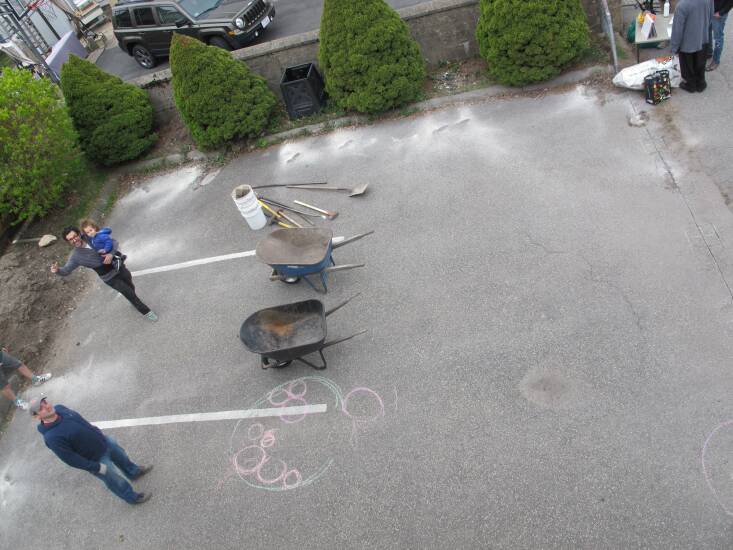 Above: The yard behind Brunelle’s home was nothing but asphalt and a few conifers.
Above: The yard behind Brunelle’s home was nothing but asphalt and a few conifers.
After
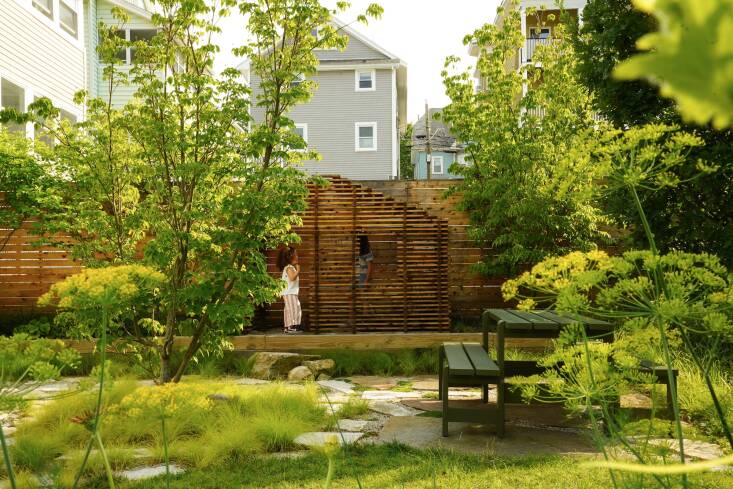 Above: The yard is now a thriving landscape that supports both wildlife and residents—adults and children alike (peep the almost camouflaged playhouse at center).
Above: The yard is now a thriving landscape that supports both wildlife and residents—adults and children alike (peep the almost camouflaged playhouse at center).
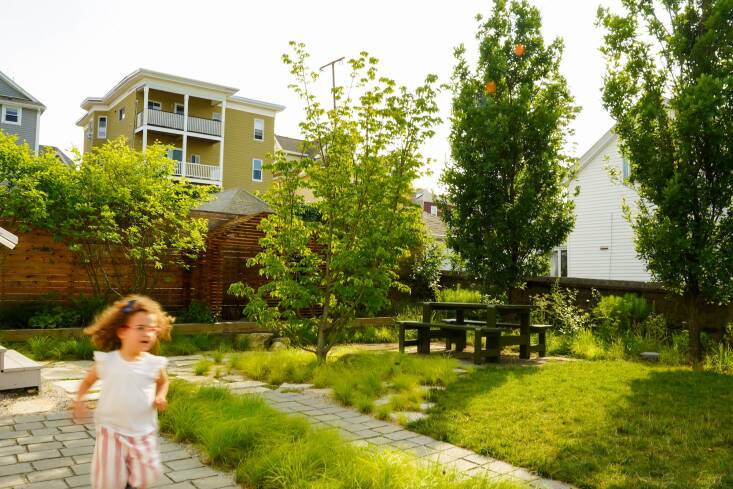 Above: Lu La Studio creaed a “ribbon” driveway. A car can park on the square pavers if needed; Carex albicans grows in the gap between the two ribbons.
Above: Lu La Studio creaed a “ribbon” driveway. A car can park on the square pavers if needed; Carex albicans grows in the gap between the two ribbons.
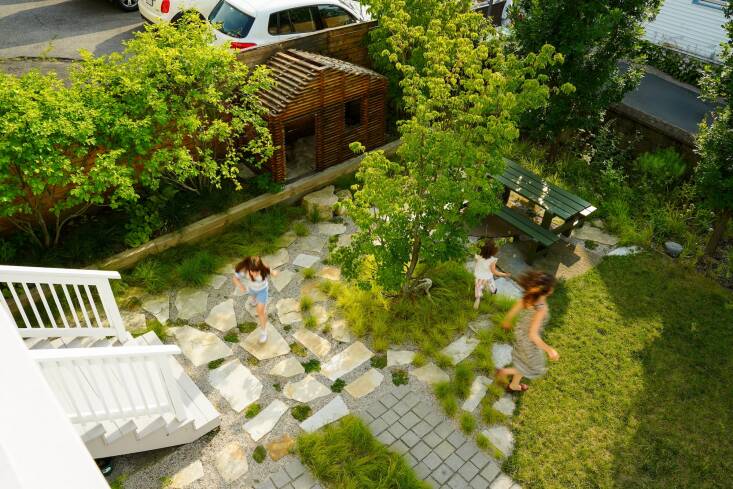 Above: Lu La Design relied on texture and materials to “define spaces and create a flow between them.” Reclaimed granite pavers appear on the front walkway, the ribbon driveway, and the threshold between the side and back yards, while irregular flagstone offer contrast in other areas.
Above: Lu La Design relied on texture and materials to “define spaces and create a flow between them.” Reclaimed granite pavers appear on the front walkway, the ribbon driveway, and the threshold between the side and back yards, while irregular flagstone offer contrast in other areas.
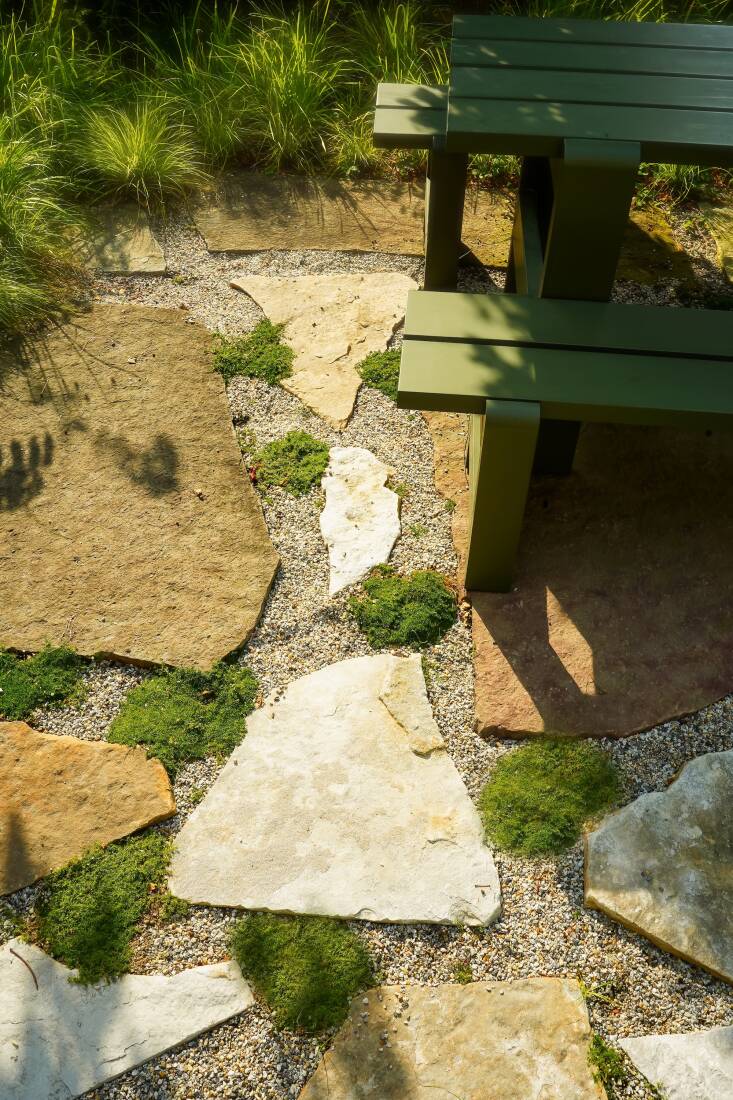 Above: The flagstone, including three extra large pieces of petrified sea bed under the picnic table, came from a local stone yard. The rock mulch has warm and cool tones that marries all the stones together.
Above: The flagstone, including three extra large pieces of petrified sea bed under the picnic table, came from a local stone yard. The rock mulch has warm and cool tones that marries all the stones together.
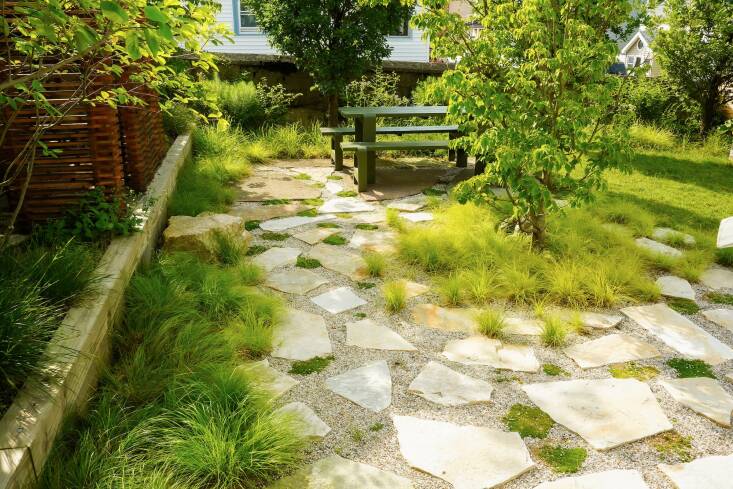 Above: The dominant longer grass-like plant is the sedge Carex albicans and under the amelanchier tree (at left) is Deschampsia cespitosa ‘Goldtau’—both are easygoing plants that can tolerate full sun and full shade conditions. Brunelle adds that sedges are one of the most ecologically powerful things you can grow because they have so much food for nesting birds.
Above: The dominant longer grass-like plant is the sedge Carex albicans and under the amelanchier tree (at left) is Deschampsia cespitosa ‘Goldtau’—both are easygoing plants that can tolerate full sun and full shade conditions. Brunelle adds that sedges are one of the most ecologically powerful things you can grow because they have so much food for nesting birds.
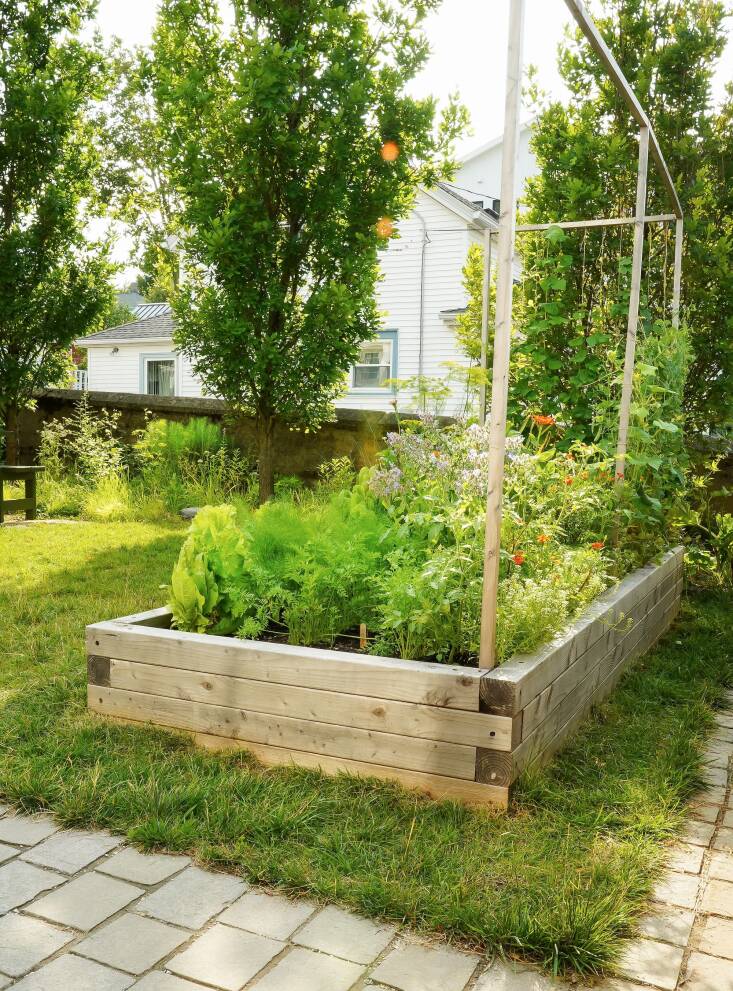 Above: Both the turf grass “play lawn” and the raised vegetable bed are relatively small in size, but they get lots of use from residents.
Above: Both the turf grass “play lawn” and the raised vegetable bed are relatively small in size, but they get lots of use from residents.
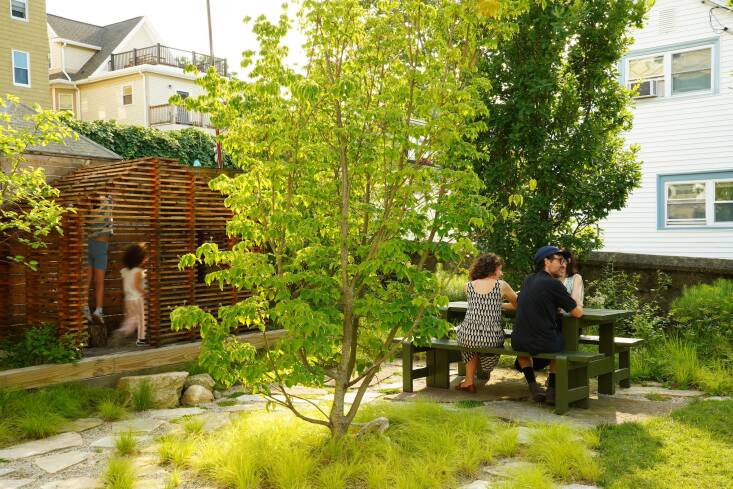 Above: “If you choose the right trees and design it right, you can put so much in,” says Brunelle, who fit eight trees onto this small lot. The whole site is graded 1-percent toward the Kousa dogwood in the center (and there’s another dogwood opposite along the fence). In addition, they planted three multi-stem Amelanchier along the side fence and three Royal oaks, a columnar tree that will create a screen when they grow in.
Above: “If you choose the right trees and design it right, you can put so much in,” says Brunelle, who fit eight trees onto this small lot. The whole site is graded 1-percent toward the Kousa dogwood in the center (and there’s another dogwood opposite along the fence). In addition, they planted three multi-stem Amelanchier along the side fence and three Royal oaks, a columnar tree that will create a screen when they grow in.
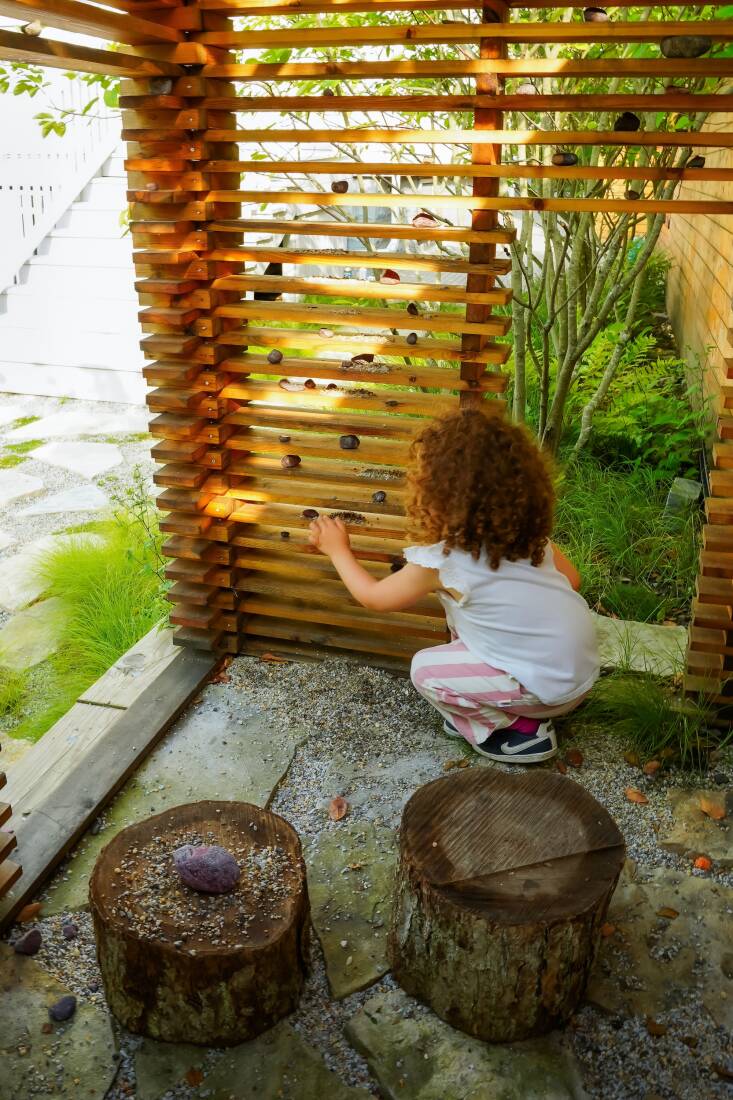 Above: The 4-x-7 foot slatted playhouse echoes Lu La Design’s Nest structures in New York City, which first brought the firm to our attention. Smith notes that the slats “invite children to collect ‘loose parts’ and engage in a rich play.” Made from the same wood as the fence, the structure recedes visually.
Above: The 4-x-7 foot slatted playhouse echoes Lu La Design’s Nest structures in New York City, which first brought the firm to our attention. Smith notes that the slats “invite children to collect ‘loose parts’ and engage in a rich play.” Made from the same wood as the fence, the structure recedes visually.
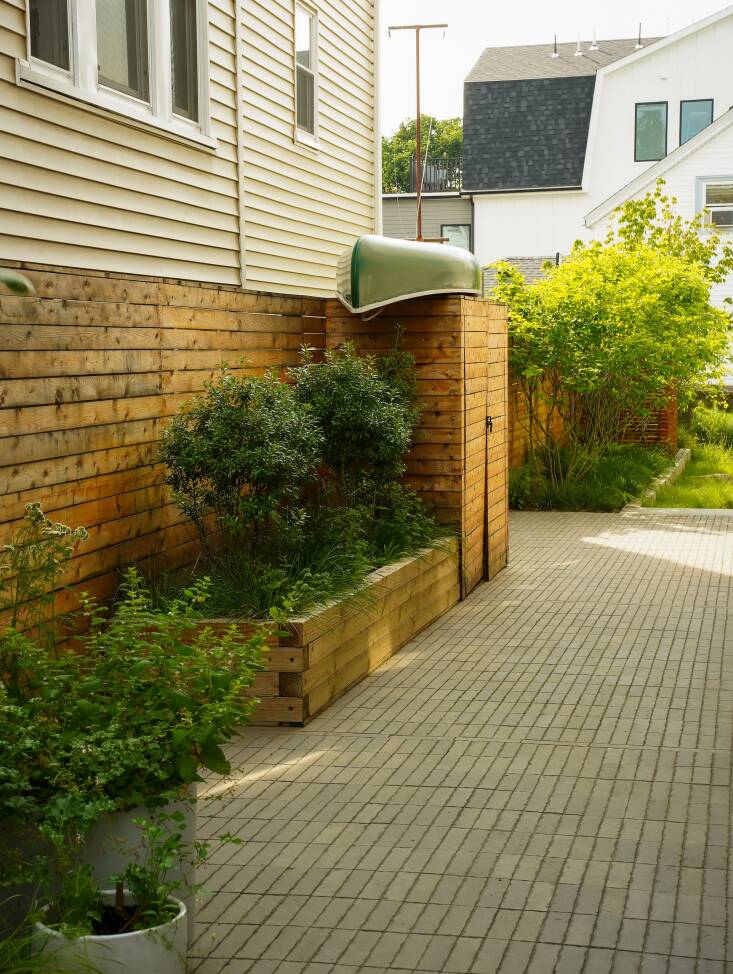 Above: The side yard is the only space with true hardscape, because so much water passes by during rain events. The concrete blocks are pitched down at 2-percent toward the backyard, where the water hits the rock mulch and percolates into the ground. Residents park their bikes here in the summer.
Above: The side yard is the only space with true hardscape, because so much water passes by during rain events. The concrete blocks are pitched down at 2-percent toward the backyard, where the water hits the rock mulch and percolates into the ground. Residents park their bikes here in the summer.
See also:



